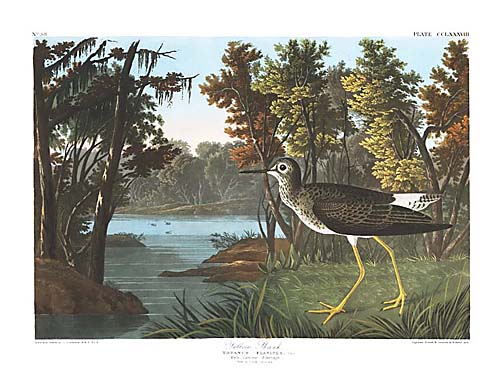|
||||||||||||||||||||
|
||||||||||||||||||||
|
|
||||||||||||||||||||
|
Ornithological Biography The Yellowshank is much more abundant in the interior, or to the westward of the Alleghany Mountains than along our Atlantic coast, although it is also met with in the whole extent of the latter, from Florida to Maine. It exceeds the Tell-tale Godwit in numbers on the shores of the Ohio, as well as on the margins of the numerous ponds and lakes in the vicinity of the Mississippi, from the mouth of the river just mentioned to New Orleans, and beyond that city southward. In early autumn, when the sand-bars of the Ohio are left uncovered, these active birds are seen upon them in small flocks, formed each apparently of a single family, busily employed in searching for food, and wading in the water up to the feathered part of their legs. When the water is high, they resort to ponds and damp meadows intersected by small rivulets. In the Carolinas and the Floridas they are pretty numerous, in the former betaking themselves to the rice-fields, and in the latter to the wet savannahs. They are equally fond of frequenting the shores of our estuaries that are bordered by salt marshes, on the muddy edges of which they find their food. I have also met with them on the margins of clear streams in the interior of the States, and indeed should hardly be able to mention a district in which the species is not to be seen, from the beginning of September until May, when the greater number retire northward, although some remain and breed, even in our Middle States, as NUTTALL says they are seen in the neighbourhood of Boston in the middle of June. I found a few on the coast of Labrador, but did not succeed in discovering their nests, which was the more surprising as these birds, according to my friend THOMAS MACCULLOCH, breed in considerable numbers about Pictou. He describes the nest as placed among the grass on the edges of the rivers and large ponds of the interior.
The flight of the Yellowshank is very similar to that of the Tell-tale Godwit. They generally run to some distance before they take to wing, stop as if to discover your intention, vibrate their body backwards and forwards, intimate by their cries the knowledge they have of the nature of the weapon you carry, and, as if convinced that you are bent on mischief, spring up, rise obliquely to some height, emit louder notes, and with continued flappings pass around you, or remove to some distant place. Their long yellow legs, which are stretched out behind, are quite conspicuous when they are on wing. Should you bring one to the ground wounded, it walks off leisurely, vibrates its body, and emits plaintive cries; and should one fall into the water under similar circumstances, it paddles its way towards the nearest shore with considerable speed. If you approach it, it may immerse its head, but it cannot dive to any depth. In very dry weather, I have observed this species on the uplands searching for grasshoppers and insects. It has been alleged that when one is wounded, its companions hover around so as to be easily shot; but this I have never observed, for although they are perhaps less shy than the Tell-tales, on such occasions, I never found one of them to remain; they seemed, on the contrary, to be well aware of the danger, and would fly quite out of sight, rising high in the air, and pursuing a direct course, emitting cries at intervals. Along the shores of the sea, they are now and then seen in company with other species, although they cannot be said actually to associate with them. In autumn they become fat, and by many are considered good eating, although they always have a kind of fishy taste not at all agreeable to my palate. Their food consists of diminutive fishes, shrimps, worms, and aquatic insects. I have represented one of these birds on the fore ground of a little piece of water a few miles distant from Charleston in South Carolina, on the borders of which, in the company of my kind friend JOHN BACHMAN and others, I have spent many a pleasant hour, while resting after fatiguing rambles in the surrounding woods. |
||||||||||||||||||||
|
|
||||||||||||||||||||


| Home | Gallery | Audubon Biography | About Edition | Testimonials | Authorized Dealers | Links | Contact Us |

© Copyright 2007-2025 Zebra Publishing, LLC. | All Rights Reserved Terms of Use
Powered by Fusedog Media Group
